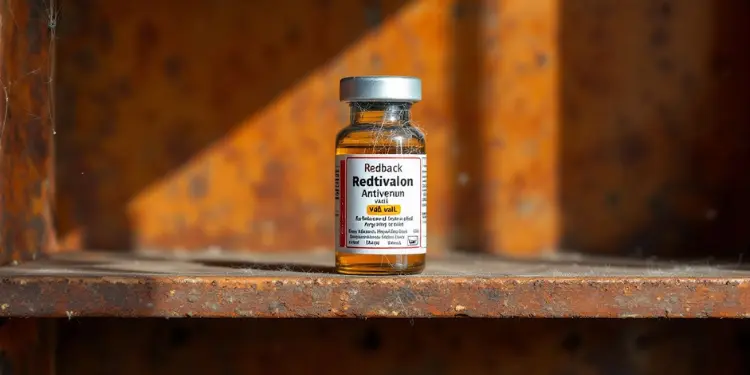Redback spiders are common in Australia, and their bites can be concerning. Redback spider antivenom is a crucial treatment for these bites. This post will inform you about this essential medicine.
Learn how to protect yourself from redback spiders.
Key Takeaways
- Redback spider antivenom is made from horses and treats bites from Australia’s most dangerous spider.
- Doctors give the antivenom through a vein to ease pain and sweating in severe cases.
- About 5,000 to 10,000 redback spider bites happen in Australia each year.
- The standard dose is two vials of 500 units each, for both adults and kids.
- Side effects can occur, with a 3.6% to 5.2% chance of severe reactions.

What is Redback Spider Antivenom?

Moving from the intro, we’ll examine the key defense against redback spider bites. Redback Spider Antivenom is an essential medicine in Australia. It’s produced to counteract the venom of redback spiders, which inhabit dry, sheltered areas.
These spiders frequently reside in sheds, cubby houses, and under shelves.
The antivenom is a clear, light straw-coloured liquid. It’s slightly viscous and transparent. Each dose contains 500 units of redback spider antivenom derived from horses. Doctors classify it as a Schedule 4 drug, requiring a prescription.
This specialised medicine aids in treating bites from the most dangerous spider in Victoria, Australia.
How Redback Spider Antivenom Works
Redback spider antivenom targets the venom’s main active component, Alpha-latrotoxin. This component opens microscopic channels in nerve cells, causing excessive signal release. The antivenom contains specific proteins that bind to the toxin, neutralising its effects and aiding the body’s elimination process.
Medical professionals administer the antivenom intravenously. It acts quickly to alleviate symptoms such as pain and sweating. The most recent guidelines for its use were published in January 2019.
These guidelines recommend antivenom for severe cases that don’t respond to pain management. Without intervention, the effects can persist for up to four days. In rare instances, symptoms might continue for weeks or months.
Indications for Use
After understanding the antivenom’s mechanism, it’s essential to recognise its appropriate use. Medical professionals administer Redback Spider Antivenom exclusively to patients exhibiting distinct symptoms, including severe pain, perspiration, and nausea.
The antivenom is most effective for pain management.
Experts estimate 5,000 to 10,000 Redback spider bites occur in Australia annually. However, not all cases require antivenom treatment. Medical professionals consult with toxicology specialists initially.
They assess whether standard pain medications are insufficient. If deemed necessary, they may opt for antivenom administration. The standard dosage is two vials, each containing 500 units.
Administration and Dosage
After discussing when to use Redback Spider Antivenom, we’ll examine how to administer it. Doctors must understand the correct method to administer this medicine to assist patients promptly and safely.
- Administer the antivenom intravenously over 20–30 minutes. Mix it with 10 ml of fluid per kg of body weight, up to 100 ml total.
- If intravenous access is unavailable, you can administer it intramuscularly without mixing it.
- Use one vial (500 units) for both adults and children. This dosage is consistent for all patients.
- You may need to administer additional doses every 2 hours if the symptoms persist.
- Continuously monitor the patient after administering the antivenom.
- Maintain IV access in case additional doses are required.
- Ensure equipment for treating allergic reactions is readily available.
- Document the amount of antivenom administered and the time of administration.
- Regularly assess if the patient’s condition is improving or if further intervention is needed.
- Cease additional doses when the patient’s symptoms improve.
Supplementary insights on Redback Spider Antivenom
Redback spider antivenom serves multiple purposes beyond treating bites. It plays a crucial role in Australian healthcare, offering distinctive characteristics and applications. Here are some additional facts about this vital medicine.
Side Effects and Precautions
Redback spider antivenom may cause side effects. Mild reactions such as rash, itching, and hives are common. Some individuals may experience breathing difficulties or dizziness. Serious complications can occur as well.
These include weak pulse, fainting, and chest pain. It’s essential to seek medical attention if any concerning symptoms appear.
Medical professionals monitor patients carefully after administering antivenom. They check for delayed side effects that can emerge days later. These might include fever, joint pain, and swollen glands.
The likelihood of a severe reaction ranges from 3.6% to 5.2%. Individuals with allergies require additional precautions. It’s crucial to inform your doctor about any health conditions before receiving this treatment.
Comparing Antivenom with Other Treatments (Comparison Table)
Antivenom isn’t the only option for treating redback spider bites. Here’s a comparison of different treatments:
| Treatment | Pros | Cons |
|---|---|---|
| Antivenom | – Targets specific venom
– Can reverse severe symptoms | – Limited evidence of efficacy
– Potential for allergic reactions |
| Pain Relief (e.g., Paracetamol) | – Easily available
– Fewer side effects | – Doesn’t neutralise venom
– May not relieve severe pain |
| Ice Pack | – Immediate application
– Reduces swelling | – Temporary relief
– Not effective for systemic symptoms |
| Opioids (e.g., Oxycodone) | – Strong pain relief
– Useful for severe cases | – Risk of dependence
– Doesn’t address venom effects |
Pain relief is key in treating redback spider bites. Paracetamol (15 mg/kg, up to 1 g) and ibuprofen (10 mg/kg, up to 400 mg) are common choices. For stronger relief, oxycodone or fentanyl might be used. The choice of treatment depends on the severity of symptoms and patient factors. For more information on spider bite first aid, visit RedBackSpider.com.
Understanding Redback Spiders: Male vs Female
Redback spiders exhibit significant differences between males and females. Female redbacks are larger and pose a greater risk. They have a black body with a red stripe on their back.
Males are much smaller and brown. They lack the red stripe. Females construct sticky webs to capture prey. Males don’t create webs. They focus on finding mates.
Female redbacks are responsible for bites on humans. Their venom is potent. It can cause severe pain and illness. Male redbacks seldom bite. If they do, it’s generally less severe.
Females have a lifespan of about two years. Males typically live for only a few months. They often perish after mating. Understanding these characteristics can assist people in staying safe around redback spiders.
Patient Care and Follow-up
After understanding the differences between male and female redback spiders, it’s important to know about patient care after a bite. Proper follow-up is essential to ensure full recovery and identify any late effects.
- Observe for at least an hour. Doctors monitor patients for 60 minutes after administering antivenom to check if symptoms recur.
- Discharge when pain is manageable. Patients can leave once they feel better and pain has decreased.
- Be aware of serum sickness. This can occur 5 to 14 days after receiving antivenom.
- Seek help if necessary. Contact the Victorian Poisons Information Centre on 13 11 26 for prompt advice.
- Special attention for children and infants. For urgent transfers to children’s or neonatal ICUs, contact PIPER Service on 1300 137 650.
- Monitor the bite site. Inspect the area where the spider bit for any changes or new symptoms.
- Rest for a few days. Recuperation helps the body heal after a spider bite and antivenom treatment.
- Adhere to medical advice. Take any medications as prescribed and attend all follow-up appointments.
- Communicate any new symptoms. Inform your doctor if you experience unusual sensations or new issues after discharge.
- Maintain hydration. Consume plenty of water to aid your body’s recovery and eliminate toxins.
Conclusion
Redback spider antivenom is effective in saving lives. It rapidly alleviates pain and aids in patient recovery. Medical professionals are skilled in its application. This treatment reduces the severity of spider bite incidents.
Individuals can feel reassured knowing an effective remedy is available if required.
For more detailed insights into the differences between male and female Redback Spiders, click here: Understanding Redback Spiders: Male vs Female.
FAQs
1. What’s the deal with redback spider antivenom?
It’s the top-notch defense against redback spider bites. This special medicine… it’s made to fight the venom of these nasty critters. Aussies know it’s a must-have in our first-aid kits, especially if you’re in areas where these spiders like to hang out.
2. How quick does the antivenom work?
Pretty fast, mate! Once you get a jab of this stuff, it starts working its magic right away. Most folks feel better in just a few hours. But remember, the sooner you get it, the better your chances of a quick recovery.
3. Can anyone use redback spider antivenom?
Well, it’s not like vegemite – you can’t just slap it on whenever you fancy. It’s a serious medicine, and you need a doc to give it to you. They’ll check if you really need it first. Some people might have a reaction to it, so it’s best left to the pros.
4. Do we have enough of this antivenom in Australia?
No worries there! We’ve got plenty of the stuff. Our clever scientists make sure we’re well-stocked. It’s available in hospitals and medical centers across the country, especially in areas where redbacks are common. So, if you ever need it, chances are it’ll be close by.





